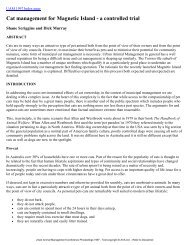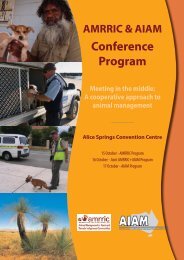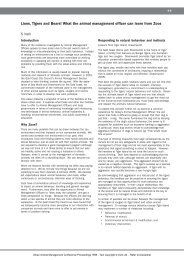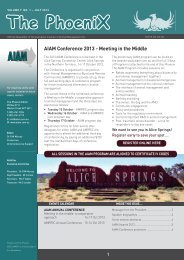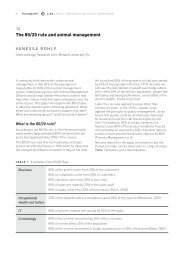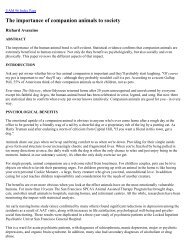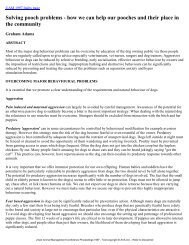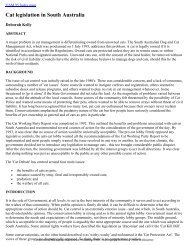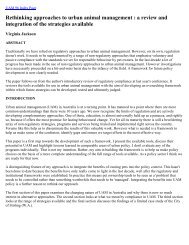Proceedings OF ThE - Australian Institute of Animal Management Inc
Proceedings OF ThE - Australian Institute of Animal Management Inc
Proceedings OF ThE - Australian Institute of Animal Management Inc
You also want an ePaper? Increase the reach of your titles
YUMPU automatically turns print PDFs into web optimized ePapers that Google loves.
96 <strong>Proceedings</strong> 2012<br />
AIAM Annual Conference on <strong>Animal</strong> <strong>Management</strong><br />
17<br />
Desexing: the overlooked way to reduce dog attacks<br />
Katina D’Onise<br />
Dog and Cat <strong>Management</strong> Board, SA<br />
Desexing <strong>of</strong> dogs results in a range <strong>of</strong> well known<br />
benefits for the dogs and their owners, including<br />
specific health benefits for dogs, improvement in<br />
the sociability <strong>of</strong> dogs, and a reduction in unwanted<br />
litters (Reichler 2009). The potential that desexing<br />
<strong>of</strong>fers to reduce the risk <strong>of</strong> dog attacks is not so<br />
widely known. Good epidemiological evidence, as<br />
well as evidence from animal behaviour science,<br />
suggests that desexing dogs is an important<br />
modifiable risk factor for dog attacks on people and<br />
on other animals. This presentation reviews the<br />
evidence <strong>of</strong> the benefits <strong>of</strong> desexing for dog attack<br />
reduction.<br />
A relatively small number <strong>of</strong> studies have been<br />
published that explore the epidemiology <strong>of</strong> dog<br />
attacks on humans (for exampleGershman et al 1994;<br />
Messam et al 2008; Overall & Love 2001; Shuler et<br />
al 2008). These studies have examined a number <strong>of</strong><br />
possible risk factors for dog attack, ranging from<br />
victim-specific factors (such as age and gender) to<br />
dog-specific factors (such as dog breed, age, gender,<br />
and training status). Beyond the effect <strong>of</strong> dog gender,<br />
some studies also examined the effect <strong>of</strong> the neuter<br />
status <strong>of</strong> dogs. These studies are observational in<br />
design and retrospective. They document the details<br />
<strong>of</strong> attacks after they have occurred. These studies<br />
are thus prone to a range <strong>of</strong> biases, in particular<br />
confounding and measurement bias, some more<br />
than others.<br />
The study by Schuler and colleagues is likely to<br />
be the least biased study published that examined<br />
the risk factors for dog attack (Shuler et al 2008).<br />
This study used a retrospective cohort design that<br />
examined all dog attack reports to the authorities<br />
over a period <strong>of</strong> one year. Another strength <strong>of</strong> this<br />
design was that dog attacks in the jurisdiction<br />
concerned were reportable by law, which was<br />
likely to lead to more complete reporting <strong>of</strong> dog<br />
attacks compared with other published studies.<br />
Further, the dog attacks came from a community<br />
sample rather than from a sample restricted to dog<br />
owners or dog owners who frequent a particular<br />
veterinarian, and thus the sample was likely to be<br />
more representative <strong>of</strong> the full range <strong>of</strong> dog attacks<br />
across the population. This study found that the<br />
risk <strong>of</strong> dog attack was greatest for intact male dogs<br />
(relative risk (RR) 18.6, 95% confidence interval (CI)<br />
13.9-24.7), and then intact female dogs (RR 10.5, 95%<br />
CI 7.4-14.8), when compared with desexed female<br />
dogs (Shuler et al 2008).<br />
It is also instructive to examine those studies that<br />
reported details <strong>of</strong> dog attacks that led specifically to<br />
severe injury or death (Sacks et al 1996; Wright 1985).<br />
Although these studies tended to provide weaker<br />
evidence (generally they used a case-series design),<br />
they present an opportunity to examine precisely<br />
those events that society most wants to prevent.<br />
Only a few <strong>of</strong> these studies were able to report<br />
on the neuter status <strong>of</strong> the attacking dog, and the<br />
information was not always complete for each attack.<br />
That said, where the information was available, the<br />
vast majority <strong>of</strong> dogs involved in severe attacks on<br />
humans were not desexed. For example, in the study<br />
by Sacks et al, <strong>of</strong> the 20 cases <strong>of</strong> attack leading to<br />
death where neuter status was known, 19 were not<br />
desexed. Further, 15 <strong>of</strong> the 20 attacks involved an<br />
entire male dog (Sacks et al 1996).<br />
The findings from animal behaviour literature can be<br />
used to ‘triangulate’ the evidence from epidemiology.<br />
That is, if the evidence from a different perspective<br />
supports the findings from epidemiology, then there<br />
is greater confidence that the epidemiologic results<br />
are an accurate reflection <strong>of</strong> the ‘real’ risk. There<br />
is consistent evidence that intact males are more<br />
aggressive than neutered males, and also that intact<br />
males are the most common group with dominance<br />
aggression (Overall & Love 2001). There is less<br />
consistent evidence however for intact females,<br />
with conflicting reports <strong>of</strong> increased or decreased<br />
dominance aggression compared with neutered<br />
females (Guy et al 2001; Overall & Love 2001).<br />
These findings are broadly consistent with those<br />
from epidemiology, given that aggression is more<br />
likely to lead to dog attacks, and the greatest risk is<br />
consistently seen with intact male dogs. This gives<br />
further confidence that the finding <strong>of</strong> reduced risk<br />
among neutered dogs is a correct reflection <strong>of</strong> a true<br />
difference.<br />
There is also good reason to promote desexing for<br />
purposes beyond the usual indications from a publichealth,<br />
injury-control perspective. On the basis <strong>of</strong> the<br />
evidence presented here, desexing <strong>of</strong> dogs is likely to



